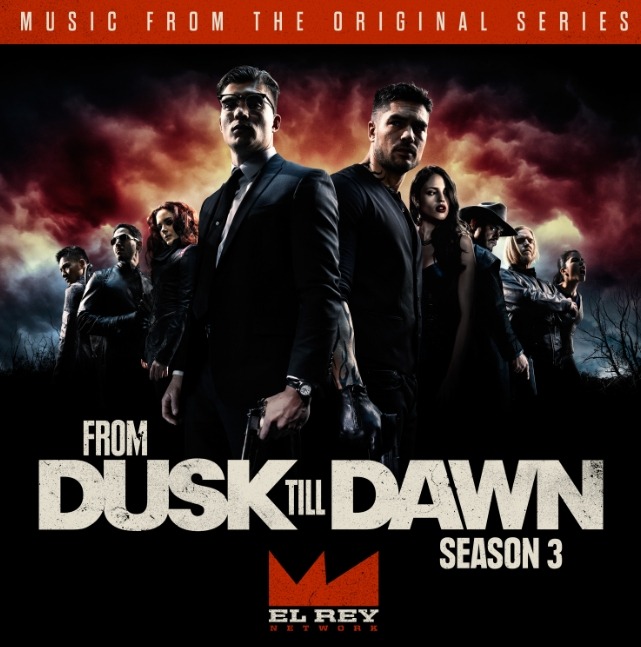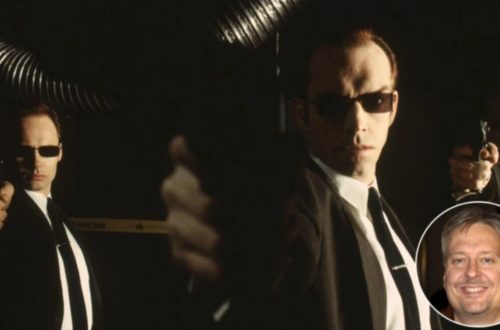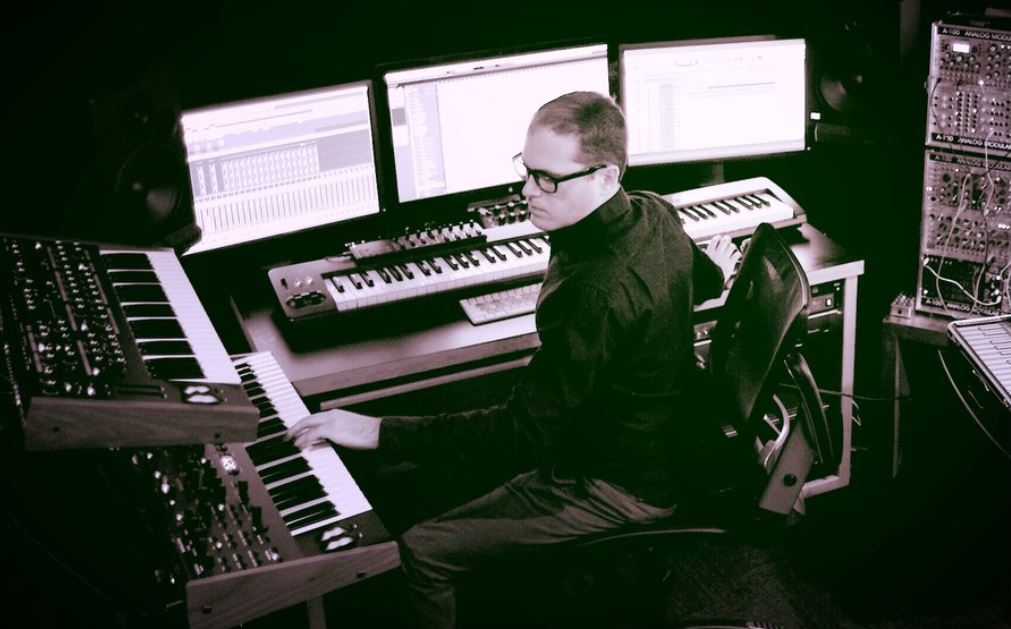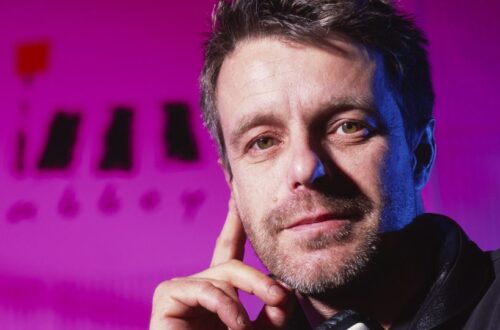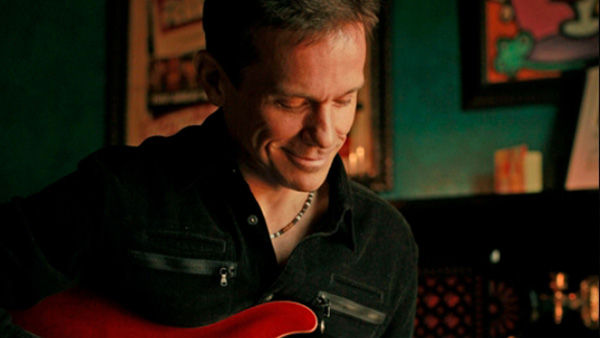 We recently reconnected with composer Carl Thiel, and realized that it’s been three years since we last chatted. At the time, he had completed recording the music for Sin City: A Dame to Kill For (with Robert Rodriguez), and was also about to begin work on the From Dusk Til Dawn TV series on the El Rey Network. In that time, Thiel continues to grow as an artist. Born in Mexico City, and after living in Canada for a while, Thiel now calls Austin home. He comes from a family of musicians, and has a lot of music he’s interested to work on away from projects under the Troublemaker Studios banner.
We recently reconnected with composer Carl Thiel, and realized that it’s been three years since we last chatted. At the time, he had completed recording the music for Sin City: A Dame to Kill For (with Robert Rodriguez), and was also about to begin work on the From Dusk Til Dawn TV series on the El Rey Network. In that time, Thiel continues to grow as an artist. Born in Mexico City, and after living in Canada for a while, Thiel now calls Austin home. He comes from a family of musicians, and has a lot of music he’s interested to work on away from projects under the Troublemaker Studios banner.
As such, he’s been able to write music that’s much different than the gritty guitar-based scores he’s known for. Thiel composed very emotionally dynamic music to Andrew Shapter’s documentary The Teller and the Truth (it’s really closer to a docu-drama), and season three of the show features a similar departure to anything previously recorded for the series. Each time we talk to Thiel, we get so much from our conversation. Of all the composers we’ve sat with over the years, no one has taught us more about the industry and the profession than him. Enjoy the highlights of our time with Carl Thiel.
GoSeeTalk: I have to say that while listening to the music in The Teller and the Truth I was amazed how much it felt like a score to a narrative. As the film played out, I understood why you wrote in this style, and it was to keep up with the changing tone and direction of the film. You worked with Andrew Shapter on Before the Music Dies. What was that like, and how did you develop your sound for this picture?
Carl Thiel: Before the Music Dies is a documentary that got a lot of recognition right around the time when music was making a transition into digital. Andrew interviewed a whole lot of
musicians for it and that was the first time I worked with him. Now The Teller and the Truth was a unique project because it starts as a documentary and then turns into a narrative. It was a very tricky film for him more than me because he took an incident that took place in real life, but nobody really knows what happened. So he took artistic liberty to create a story from that seed.
What was great for me was that there was no actual dialog. It’s a lot interviews punctuated with a lot of dramatization, but those were all silent, so there was a lot of room for me to work. Andrew comes from a photography background, so everything he shot to embellish the story, or the legend surrounding this bank teller, are these beautiful vistas and everything, every shot, looks like a postcard. These big open moments were just begging for music and it created a unique canvas for me to work on.
These days, on most movies the music has to work alongside a lot of other audio elements, so it was great not to have to compete with dialog or sound effects. Andrew went all over the world shooting this so there was a lot of great visual material to draw inspiration from.
The themes in the opening credits really drew me in, and I love it when you listen to music and can’t tell who composed the music. It felt so fresh, and compelling, and really followed the dichotomy of the story. Also, I imagine it must have been nice to work on something completely different than the sound you help bring to various Robert Rodriguez productions.
Growing up, I learned classical music and my Dad was a concert pianist. Of course, working with Robert has been a huge blessing in my career, and I love it. But there’s a lot of other music I have inside that I haven’t had a chance to express publicly. This was a nice departure and allowed me an opportunity to do that.
The score was very layered, complex and impacting and really made you feel for these characters, even if it took a fictitious turn halfway though.
It was truly a labor of love for everyone involved. This was a low budget film, but Andrew was surprisingly economical and really used his resources to make this work. As a photographer, he’s continually hired for commercials and different projects that take him all over the world. In one particular instance he was hired by Willy Nelson to film footage from several of his concerts. So, very smartly, Andrew hired actors as his assistants. So in between working with Willy, he’d take the actors out to the Grand Canyon or the Golden Gate Bridge and other places like that, on Willy’s penny and continued gathering the footage he wanted to tell this story.
It took him about five years to put this all together – including trips to Paris, Spain, even India – and it looks like he had this huge budget, but he really didn’t. The story evolved as he shot it. He had an idea of where he wanted it to go, but he had to be flexible after seeing what footage he got. Now because of that, I also had more time to work on it.
When did you first get to see footage and what did you start on?
Andrew put together a teaser trailer and I based all my ideas on that. The first thing he was able to show me was the first ten minutes and
I began working on that. All the melodic themes blossomed from that, and I was working on different projects so I would come back to Andrew between projects – two weeks here, another there – or whenever he had more footage to show me.
It was back and forth like that because the fee was small, but we didn’t have a hard deadline so we took our time to make sure we did it right.
In a film, we can expect to be manipulated by the music. What rules do you have for scoring that versus a documentary, or when working on a feature versus TV?
Well, for me, it really bothers me when I’m watching a documentary and the music is really hitting me over the head. I like to be able to make up my mind after having the
facts or events presented to me. But you’re right, the whole process of film scoring is geared toward manipulation by nature.
We go to movies to have an emotional reaction, so you can’t get away from that when you’re scoring. But the import thing is to find the subtleties. What I’ve learned through the years is not to score directly to what’s on the picture – you’re looking to score the subtext. Early on, Robert and I would talk and he’d tell me that the score is like an additional actor, the music has to say what the actors aren’t.
So if it’s a documentary or a film, or TV, to me it’s all art. I look at it as how I can best serve the project. When I first started working on Andrew’s film, I hadn’t seen any footage. When we talked about the project, it sounded like it was going to be a murder mystery kind of thing, so I wrote some demos that were sleuthy, and there was no romantic element to it.
Then when I started seeing footage, and saw how the story evolved, I realized it was really a love story above and beyond the mystery. So I tossed out everything I had written and started fresh with that perspective. That helped me focus a lot better on what to do and what was right for the project.
I don’t think I would have used the term “love story”, but that makes sense. The film did chronicle this woman’s heartbreaking downward spiral, but, as you said about other documentaries you’ve seen, I never felt like I was being told how to feel. Your music made me feel involved in the story.
We had some discussions as to where we wanted or needed music. There were a lot of scenes with interviews, with many people giving their input as to the accounts of the events, and without music, it felt like the story was stalling. We needed something to propel it forward because there’s only so much an audience take watching straight interviews – it starts getting monotonous. So we put music under all that, and most of it has some kind of pulse to keep the momentum going. Even if it’s a slow pace it still keeps it moving forward.
Working on film, it can be feast or famine, but I do know that TV can be a non-stop grind for close to a year. What do you prefer?
I get a rush working on TV; I’m not going to lie, I really enjoy it. But I have to tell myself that I’m not going to see daylight for the next four months. [Laughs] The beginning of a TV show is always a little more comfortable, and then as we get to the last few episodes time really crunches and you deal with
tighter deadlines as you get closer to air time. But whether it is season one or ten, you need that time at the beginning because you’re developing new themes and sound palettes so it’s more about experimentation.
At the end you’ve got the momentum and all the themes have been established so you can go faster. You don’t have time to second guess – most of what you deliver is what they’re going to get – but it doesn’t mean you don’t give the project your best. Sometimes I’ll get notes, and most of the time they’re very reasonable, and you crunch to deliver those. But at the end of the season, you look back on the body of work you created and you’re amazed that in a 45 minute show, you deliver close to 40 minutes of music…each episode. It’s a point of pride. But I do like the pace of a movie as well and I feel you have more time to experiment and play and find new tone palettes.
With TV you have familiarity with the mixers, crew, etc., and in film you could be done in two months and you many never see or work with any of those professionals again. They are each special and unique. If anyone had asked me 5 or 10 years ago if I wanted to do TV, I would have had reservations.
Nowadays, TV has really come a long way, and thanks to the way Netflix has revolutionized the way people consume television, you can watch a season over a weekend and get the same level of completion as you would watching a long film, or reading a novel.
You can binge watch and see how the arc, both music and narrative, play out over several episodes easier than if you had to watch one episode a week for a whole Summer.
That makes it a different art form than what it used to be. When the episodes could live as stand alone pieces, you could put them out of order and still understand the show. Now, you can create intricate story lines that evolve over the period of a season. You can count on the audience remembering what happened in the previous episode because changes are they just finished it five minutes ago. [Laughs]
TV shows have a cadence so what’s it like working with a fixed run time?
You’re right, TV has a structure you have to work within. For example, there are a lot of music swells that go up to commercial, and I have to work with many devices on a TV show that are not necessary on a movie. But when you get comfortable with a format, you can keep that rhythm. A movie can have more freedom, and you can have longer pieces of music that don’t have those limitations.
Now I used to do music for commercials back in the ’90s and that taught me a lot, because you had to write something that delivers the goods within 30 seconds, and so that gave me a lot of experience on how to work within the restrictions of a format. When you write something that’s not going to go to picture you may end up stretching the introduction, have an 8 bar verse or a 16 bar movement.
But when you’re writing for a 30 second commercial, the intro ends up being one bar or maybe even half a bar. You’re always asking yourself, “how can I make this effective? How can I evoke an emotional response within a short period of time?” It taught me how to cut the fat. What’s the least amount of melody we can get away with so that it’s still memorable, and it fits within the time limitation?
What’s new, musically and in a narrative sense, in Season 3 of From Dusk Til Dawn? Also, I know that you and Robert pride yourselves on the digital libraries, but those guitars sound so great and dynamic they have to be real – it has a very hard ’80s era edge to it. So what was real, and what was sampled? What are you the most excited to have done in this season and how has the sound evolved?
I am fond of sample libraries, and some of the guitars in those libraries are good, but there’s something about a string instrument like a guitar that you just can’t replicate. I’m glad you noticed that because you’re validating what I did – they are live guitars. Every time you pluck a sting you get a different tone, and how hard you press the strings with
your finger alters the sound, or bend them.
You can reproduce them to a point but it will never get to the reality of how a guitar should and can sound with a real instrument. Part of the signature of Robert Rodriguez’ sound is the guitar, that gritty edge in practically everything he does – it’s part of the genre he carries forth.
This third season was a departure from the first two in that it became ‘monster of the week’ in its presentation format. Each week there was a new demon or underworld creature that our heroes had to combat. It was exciting and challenging in that each episode had its own flavor with a new theme for each monster. The different elements I had written up until the last two or three episodes all made a come back in the final episodes.
There was also a lot of chanting in this season. When we started talking about ideas, Carlos Coto (the show runner) and Robert said they wanted to really go over the top with this using a lot of choir and really create the sound from Hell. [Laughs] That’s me doing the chanting, mixed in with some samples, to give it the tribal, Mesoamerican underworld edge we were looking for. It was a lot of fun and I’m really happy with how it turned out. This was my favorite season so far.
One of the top episodes for me was “Straitjacket” the one that took place in “Nicotero Hospital”, directed by Rebecca Rodriguez (Robert’s sister). It’s a very mental episode and it’s fantastic.
As always, thanks to Carl for his time. Check out more of his work on his official website: carlthiel.com
The Teller and the Truth and Season 3 of From Dusk Til Dawn are both available digitally now. Listen to samples of them on iTunes by clicking the links below.

